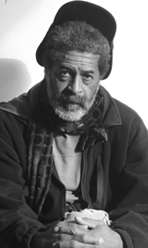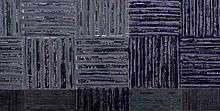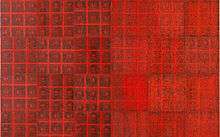McArthur Binion
McArthur Binion (born 1946) is an American artist based in Chicago, Illinois.
Binion was born in Macon, Mississippi.[1] He holds a BFA from Wayne State University (1971) in Detroit, Michigan and an MFA from Cranbrook Academy of Art in Bloomfield Hills, Michigan. He has been a Professor of Art at Columbia College in Chicago since 1993.[2]
Early Life
Binion was born in 1946, one of eleven children, on a cotton farm in Macon, Mississippi, where he helped to work row after row of soil, a birthright that paid off both aesthetically and ethically. He moved to Detroit where his father took a job in an auto plant. He struggled with a stutter until he was 19, citing his speech impediment for his reliance on non-verbal mediums. He claims that the same year he stopped worrying about his stutter, he dropped out of college and moved to New York, and found his way into a museum on a work errand. "I'd never been to a museum before," he recalls. "I never understood that painting could be of a philosophical nature. It really got me." Binion returned to school, to pursue the arts. "It took me two or three years to build up the courage, most of the things I tried I could do really well--but drawing was the first thing I had ever done that I totally had nothing going. It was an emotional experience. All these other kids had been drawing all their lives and I was 22 without experience." In 1973, he became the first African American to graduate from Cranbrook with an MFA. He returned to New York as the Soho art scene was dawning in the early seventies and found himself in a nexus of contemporary art, amid such figures as Dan Flavin, Sol LeWitt, Jean-Michel Basquiat, Gordon Matta-Clark, dealer Mary Boone, et al. "We were all there, and for me it was like I finally met my colleagues.[3]
Career
An active artist since the 1970s, his work has been featured in group shows and the focus of solo shows at the Detroit Institute of Art, Michigan Council for the Arts, the Small Walls Gallery, the Peg Alston Gallery, Saginaw Museum of Art, Artist Space, and the Susan Caldwell Gallery. Binion's paintings have been featured in such museums as the Contemporary Arts Museum Houston,[4] the Studio Museum in New York,[5] and the Detroit Institute of Art. His lucky break came in 2013 when revered Chicago dealer Kavi Gupta saw his work and immediately wanted to show his abstractions from the 70s–a show that brought about sales and serious acclaim. His solo work has been shown extensively, including most recently his 2015 show Re:Mine at Galerie Lelong in NYC, his 2014 & 2013 exhibitions DNA Study & Ghost:Rhythms at Kavi Gupta in Chicago, his 2012 show Perspectives 177: McArthur Binion at the Contemporary Art Museum, Houston and his 2010 exhibition Color Exploration: Simplicity in the Art of McArthur Binion at the University of Maryland University College Gallery.[6]

Work
McArthur Binion's work primarily consists of minimalist abstract paintings, created using crayons, oil stick, and ink, often on rigid surfaces such as wood or aluminum. For many years, Binion has been incorporating laser-prints as a collaged ground on top of which he applies other mediums. Despite being known as a Chicago artist, his work has been compared to Dorothea Rockburne, Robert Mangold, Robert Ryman and Jasper Johns’s “The Dutch Wives” paintings at times.[7] His work is deceptively complex, although his paintings appear to be works of abstract minimalism, they draw on numerous influences.
In his most recent exhibition, Binion’s paintings aren’t fully abstract, but attempt to talk about the black experience and his personal history at the same time. Acting as a kind of template for gridded marks in black, white and occasionally brightly colored oil-paint-stick layered on top, are pages from Mr. Binion’s copious old address books, passport ID and negatives of his birth certificate. Besides lending these paintings a painterly texture, the words overtly introduce narration. Binion is emphatic about the primary importance of narrative, citing his own personal history as his fount of inspiration. "I'm coming from some place that's not part of an historical lineage," Binion says. "I already had my voice," he adds. "I had to find my hands."[3]
Ghost: Rhythms, a 2013 of early work at Kavi Gupta Gallery, shows the influence of action painting, Abstract Expressionism and Minimalism. Binion pulls stylistic tropes common to folk artists as well, borrowing quilting patterns, layering photographic imagery and motifs and grids. He does all this while using one implement: his characteristic "crayon," or paint stick, which allowed him to move past oil paint. "In 1972 when I started to use them, they were basically industrial marking sticks," he recalls.[3] Binion effectively converts an elementary tool into a refined hand-held instrument. He thrives in the effort of that conversion, having developed an ornate and labored approach that demands strenuous hours, and—as Binion has noted—resonates with the cotton-picking of his childhood. He had to train himself to be ambidextrous to negotiate hand fatigue, and works an entire surface of a painting in one sitting, before returning to rework that surface the next day or week or month. Some works take years to complete. Depending on how long he lets the paint dry, it becomes more or less malleable, responding to his hand like pigmented, sculptural putty. What results is a mash-up of pointillism.
“The part I took from Minimalism is that you want to do your own stuff in your own image,” Mr. Binion says in the release for this show, and this is what he always did, as one can see in the exhaustive yet delicate marks of Icecicle: Juice from 1976, which emanate an uncanny shimmer.[8]
Small works like MAB: 1971: VIII, 2015, almost naively ram a puzzle of Mr. Binion’s portrait ID photos (the kind we all know and don’t necessarily love) directly up against the artist’s overlaid lines of oil bar, but the outcome is phenomenal. Binion’s work isn’t specifically race-related, but the pictures of the artist in his youth (with rounded afro) take stock of unaccounted for signifiers that collapse into his own particular story.
Larger works like DNA: Black Painting: Ph Bk / B Cert: II, 2015 also sideswipe racial connotation with color as racial terminology, while also ratcheting up the artist’s litany of Op art effects, ranging from Mr. Ryman’s sly use of chromatic underpainting to Jasper Johns’ shifting avalanche of cross-hatch marks.
Like many successful artists that fit the modernist profile, Mr. Binion makes work that is a study in oppositions: line and shape, figure and ground, image and abstraction, copy and original, color and black & white. His modus operandi is to somehow magically blend an assault of binaries into a single, unified emblem of the unique and complicated self.[8]


References
- ↑ "Kavi Gupta Gallery : McArthur Binion". kavigupta.com. Retrieved 2014-06-15.
- ↑ "Columbia College Chicago : McArthur Binion". colum.edu. Retrieved 2014-06-15.
- 1 2 3 "art ltd. magazine". www.artltdmag.com. Retrieved 2015-11-11.
- ↑ "Perspectives 177: McArthur Binion | Contemporary Arts Museum Houston". camh.org. Retrieved 2014-06-15.
- ↑ "When the Stars Begin to Fall | The Studio Museum in Harlem". studiomuseum.org. Retrieved 2014-06-15.
- ↑ "Kavi Gupta Gallery : McArthur Binion". kavigupta.com. Retrieved 2015-11-10.
- ↑ Plagens, Peter. "Art Review: Sarah Sze, McArthur Binion and Dana Schutz". Wall Street Journal. ISSN 0099-9660. Retrieved 2015-11-11.
- 1 2 "Rediscovered: A 70-Year-Old Artist's Second Act". Observer. Retrieved 2015-11-11.